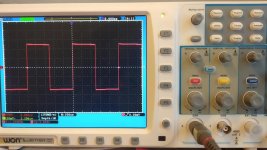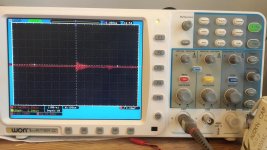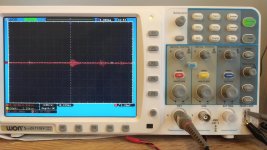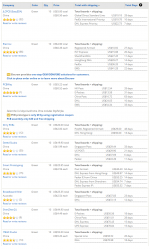I read a bit about ESR measurement. Mark, how do you do it? How would I do it. I own a LRC meter and a true MRS volt meter.
//
//
I used my 5v 1kHz square wave calibration output of my scope. Did a comparison of dropped voltage when cap shorted the output. At this low frequency, there was no difference to a high quality 10uF poly cap. Looking with the scope for HF residuals I see no difference except for the poly, I see some slow alternating wave going on which I assume is due to the higher xo for the smaller uF cap. What do you say - seems OK?
//
//
Attachments
If you don't already own a high sensitivity LCR meter, you won't be able to measure ESR to the accuracy needed in this case. Since the price of these instruments range from $350 (used) to $2000 or more (new), it will be far FAR cheaper to simply remove the old and questionable capacitors, replacing them with the Kemet capacitors whose part number is given in post #1.
Here are some examples showing representative prices of brand new, factory fresh instruments
https://www.amazon.com/Capacitance-Resistance-Impedance-Inductance-Measurement/dp/B07Q7GR8FF
Fast arrival ET4510 LCR Meter with 100KHz(Continuously adjustable frequency, 1Hz step) Accuracy:0.2%|Resistance Meters| - AliExpress
https://www.testequipmentdepot.com/instek/lcr-meters/compact-lcr-meter-lcr-6100.htm
https://www.newark.com/keysight-technologies/u1732c/handheld-lcr-meter-184-x-87-x/dp/47T6071
https://www.tequipment.net/BK/891/LCR-Meters/?v=7388
Used equipment is often cheaper -- if you can find what you want, and if it is in good working condition.
Here are some examples showing representative prices of brand new, factory fresh instruments
https://www.amazon.com/Capacitance-Resistance-Impedance-Inductance-Measurement/dp/B07Q7GR8FF
Fast arrival ET4510 LCR Meter with 100KHz(Continuously adjustable frequency, 1Hz step) Accuracy:0.2%|Resistance Meters| - AliExpress
https://www.testequipmentdepot.com/instek/lcr-meters/compact-lcr-meter-lcr-6100.htm
https://www.newark.com/keysight-technologies/u1732c/handheld-lcr-meter-184-x-87-x/dp/47T6071
https://www.tequipment.net/BK/891/LCR-Meters/?v=7388
Used equipment is often cheaper -- if you can find what you want, and if it is in good working condition.
I understand. Can you please say something about my simple measurement above?
I assume it's not adequate - what is the no1 major flaw?
//
I assume it's not adequate - what is the no1 major flaw?
//
My approach was to pay the (big!) money to purchase a precision instrument. Then trust the instrument designers to implement a reliable and accurate test procedure.
Studying several "do it yourself with gear you already own" websites and videos, I notice a common theme: they all tell you to use a function generator which makes known-to-be-excellent square waves, and they tell you to carefully measure its output impedance yourself.
The waveforms seen on these web pages and Youtube videos, do not look like the scope shots in post #142, making me suspect there could be one or more mistakes in your methodology. Check the sites below to see what they do and how they do it.
If you decide to pursue ESR-measurement-without-an-ESR-meter further, you do have one advantage which others don't: you've got a Mouser bag full of precision resistors whose value (0.04 ohms) is just exactly right for calibrating an ESR tester. Install the resistor where the capacitor-under-test would normally go, and measure its "ESR". If your measurement procedure says "ESR = 40 milliohms", congratulations, that's the right answer. If not, work on your calibration some more.
ESR meter - Wikipedia
A Simple Method for a Capacitor’s ESR Measurement – Passive Components Blog
#135: Measure Capacitor ESR with an Oscilloscope and Function Generator - YouTube
A Simple Method for a Capacitor’s ESR Measurement | Power Electronics
Geoff's Projects - Measuring Capacitor ESR
https://www.allaboutcircuits.com/te...uivalent-series-resistance-esr-of-capacitors/
https://www.element14.com/community...uring-an-aluminum-electrolytic-capacitors-esr
Studying several "do it yourself with gear you already own" websites and videos, I notice a common theme: they all tell you to use a function generator which makes known-to-be-excellent square waves, and they tell you to carefully measure its output impedance yourself.
The waveforms seen on these web pages and Youtube videos, do not look like the scope shots in post #142, making me suspect there could be one or more mistakes in your methodology. Check the sites below to see what they do and how they do it.
If you decide to pursue ESR-measurement-without-an-ESR-meter further, you do have one advantage which others don't: you've got a Mouser bag full of precision resistors whose value (0.04 ohms) is just exactly right for calibrating an ESR tester. Install the resistor where the capacitor-under-test would normally go, and measure its "ESR". If your measurement procedure says "ESR = 40 milliohms", congratulations, that's the right answer. If not, work on your calibration some more.
ESR meter - Wikipedia
A Simple Method for a Capacitor’s ESR Measurement – Passive Components Blog
#135: Measure Capacitor ESR with an Oscilloscope and Function Generator - YouTube
A Simple Method for a Capacitor’s ESR Measurement | Power Electronics
Geoff's Projects - Measuring Capacitor ESR
https://www.allaboutcircuits.com/te...uivalent-series-resistance-esr-of-capacitors/
https://www.element14.com/community...uring-an-aluminum-electrolytic-capacitors-esr
Thanks for the links!
Only one 0R04 left but thats enough! 🙂
Note that the scope shots where on 100nS/div except of course the square wave.
This gave me the inspiration for my trials...
https://www.google.com/url?sa=t&rct...=115erzCCxgE&usg=AOvVaw0KZOdKEt7SKlQRoL7c49h-
//
Only one 0R04 left but thats enough! 🙂
Note that the scope shots where on 100nS/div except of course the square wave.
This gave me the inspiration for my trials...
https://www.google.com/url?sa=t&rct...=115erzCCxgE&usg=AOvVaw0KZOdKEt7SKlQRoL7c49h-
//
Last edited:
Does anyone in the EU by any chance have a spare board they would be willing to sell on?
hey there, I have a bunch coming but I am not able to process until the end of next week. I am giving them out for free. A $2-3 donation would be appreciated, but is completely optional. I am going to donate all proceeds to diyaudio, pm me with your address, I will keep sending them and until they are gone.
hey there, I have a bunch coming but I am not able to process until the end of next week. I am giving them out for free. A $2-3 donation would be appreciated, but is completely optional. I am going to donate all proceeds to diyaudio, pm me with your address, I will keep sending them and until they are gone.
konst, I sent you a PM. I would like to try this on my nutube preamp.
Gerber files for the rev-A PCB are attached to post #1 of this thread; anyone can send these files off to a PCB fab, and get as many boards built as they like, with my blessings and good wishes.
Here are today's price quotes, for quantity=10 PCBs, made on the super thin 0.6mm boards as shown in the photo. I got the quotes from pcbshopper dot com . Click on the image to remove distortion, and then click again on the white "X" at bottom left, to see it full size.
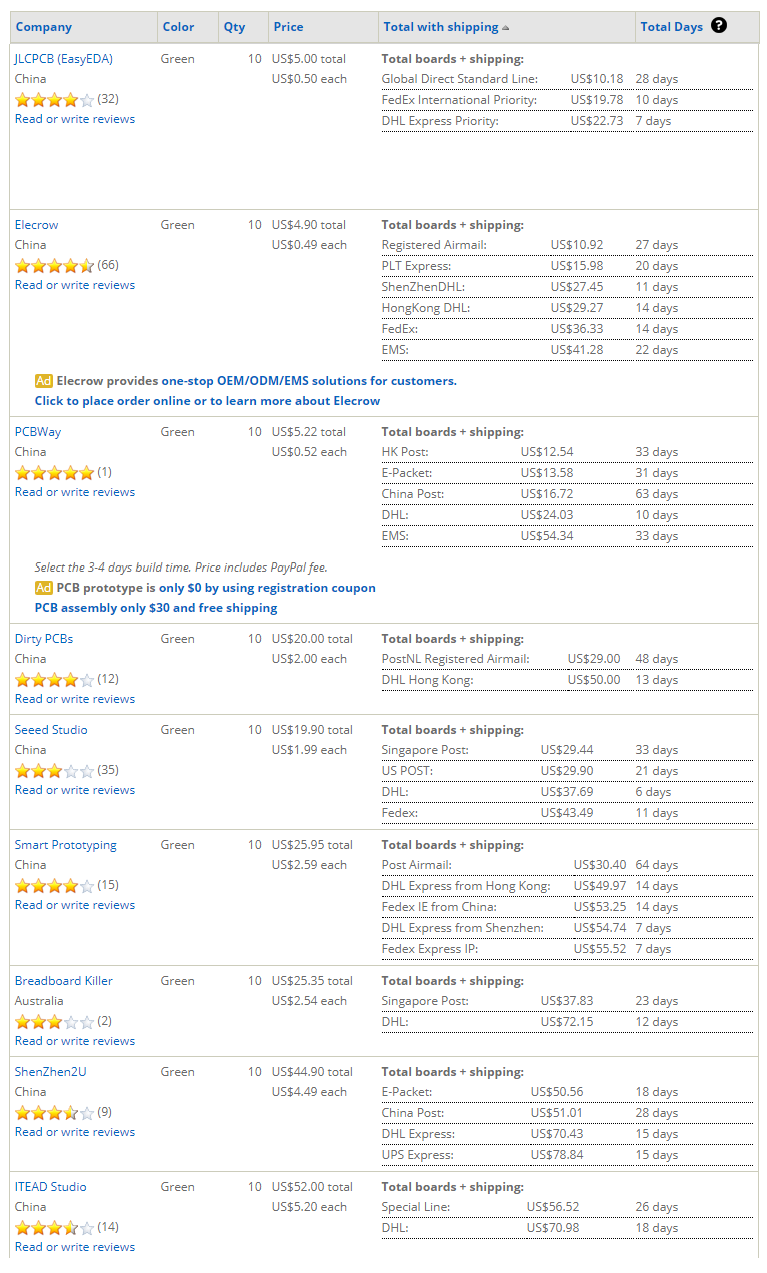
_
Here are today's price quotes, for quantity=10 PCBs, made on the super thin 0.6mm boards as shown in the photo. I got the quotes from pcbshopper dot com . Click on the image to remove distortion, and then click again on the white "X" at bottom left, to see it full size.
_
Attachments
Hi Mark,
Thank you for making this circuit freely available to this community. I've just placed an order for 30 of them.
I intend to use several myself for my B1Korg, two iterations of the Starving Student and an AKSA-Lender preamp too. I'm sure there will also be other projects in the future so I'll keep a couple in a drawer too.
The remaining boards will be free to anyone who asks. I will only ask for price of posting them.
Thank you for making this circuit freely available to this community. I've just placed an order for 30 of them.
I intend to use several myself for my B1Korg, two iterations of the Starving Student and an AKSA-Lender preamp too. I'm sure there will also be other projects in the future so I'll keep a couple in a drawer too.
The remaining boards will be free to anyone who asks. I will only ask for price of posting them.
That is very generous of you, SuppersReady !! Good on ya, and thank you on behalf of all diyAudio members in your part of the world!
Mark
Mark
Very generous indeed, bravo!
Let us know when you have some left, those deserve indeed being used 🙂
Claude
Let us know when you have some left, those deserve indeed being used 🙂
Claude
Thanks Mark,
The hard work here was done by by you. Also, I would never have considered producing pcbs prior to reading this thread. I didn't know it could be done so cheaply!
I've gained a great deal from being part of this forum, so I felt it was an good way to give something back.
And thanks to ClaudeG. Your posts on the B1Korg thread encouraged me to look into this filter. Parts on their way from Digikey already.
The hard work here was done by by you. Also, I would never have considered producing pcbs prior to reading this thread. I didn't know it could be done so cheaply!
I've gained a great deal from being part of this forum, so I felt it was an good way to give something back.
And thanks to ClaudeG. Your posts on the B1Korg thread encouraged me to look into this filter. Parts on their way from Digikey already.
This thread inspired me to use a SMPS for my crossovers. Grabbed an old printer supply, 24V DC. I then fed it to a pair of 4700 uF 63V caps separated by a 10 Ohm resister. I drop only a little over a volt to feed the on-board 317 regulators I set to 18V.
Measuring the crossover output, ripple is just at my noise floor, roughly 120 dB down. No spurious noise. I actually see a cleaner signal on the scope going into the board than on the output of the regulators. If it was not for surface mount, I would put on newer low noise chips. I may tackle it eventually.
Measuring the crossover output, ripple is just at my noise floor, roughly 120 dB down. No spurious noise. I actually see a cleaner signal on the scope going into the board than on the output of the regulators. If it was not for surface mount, I would put on newer low noise chips. I may tackle it eventually.
Mark, thank you so much for this project, this is the final part that will make me skip linear power supplies for good. I might even try out a variation or this for my TPA3255 amp.
I'm about to order 10 boards from JLCPCB, 6 boards I have allocated for my own projects and will probably hang on to one or two more. I can easily order a few more boards so if there are any takers, send a PM and I will send them for postage only inside EU.
My order will be placed on Sunday this week.
I'm about to order 10 boards from JLCPCB, 6 boards I have allocated for my own projects and will probably hang on to one or two more. I can easily order a few more boards so if there are any takers, send a PM and I will send them for postage only inside EU.
My order will be placed on Sunday this week.
Last edited:
- Home
- Source & Line
- Analog Line Level
- PO89ZB, an inline DC filter for SMPS wall warts. Preamps, HPA, Korg NuTube, etc
